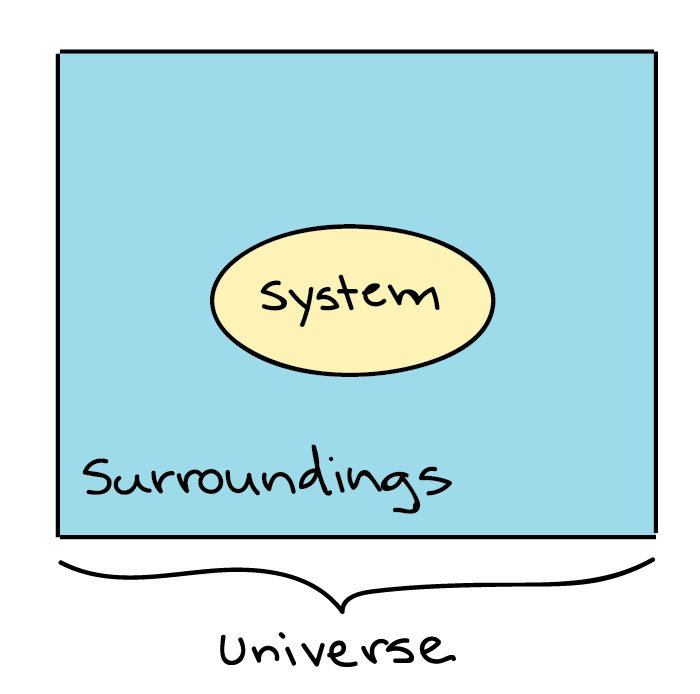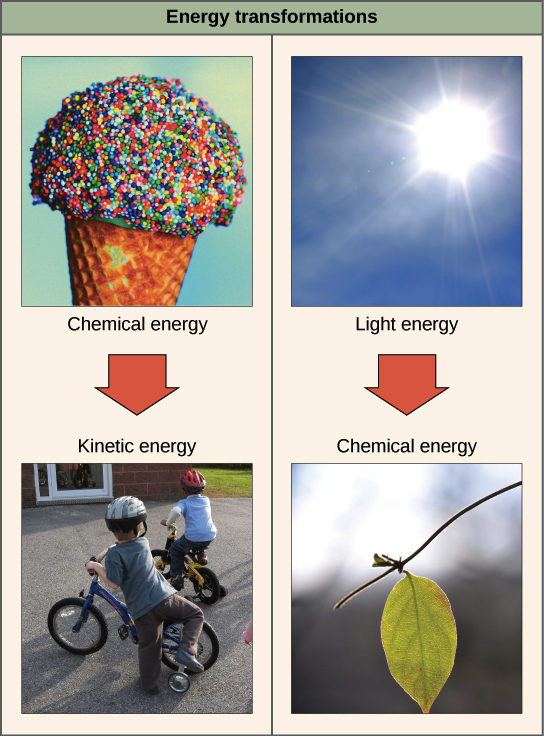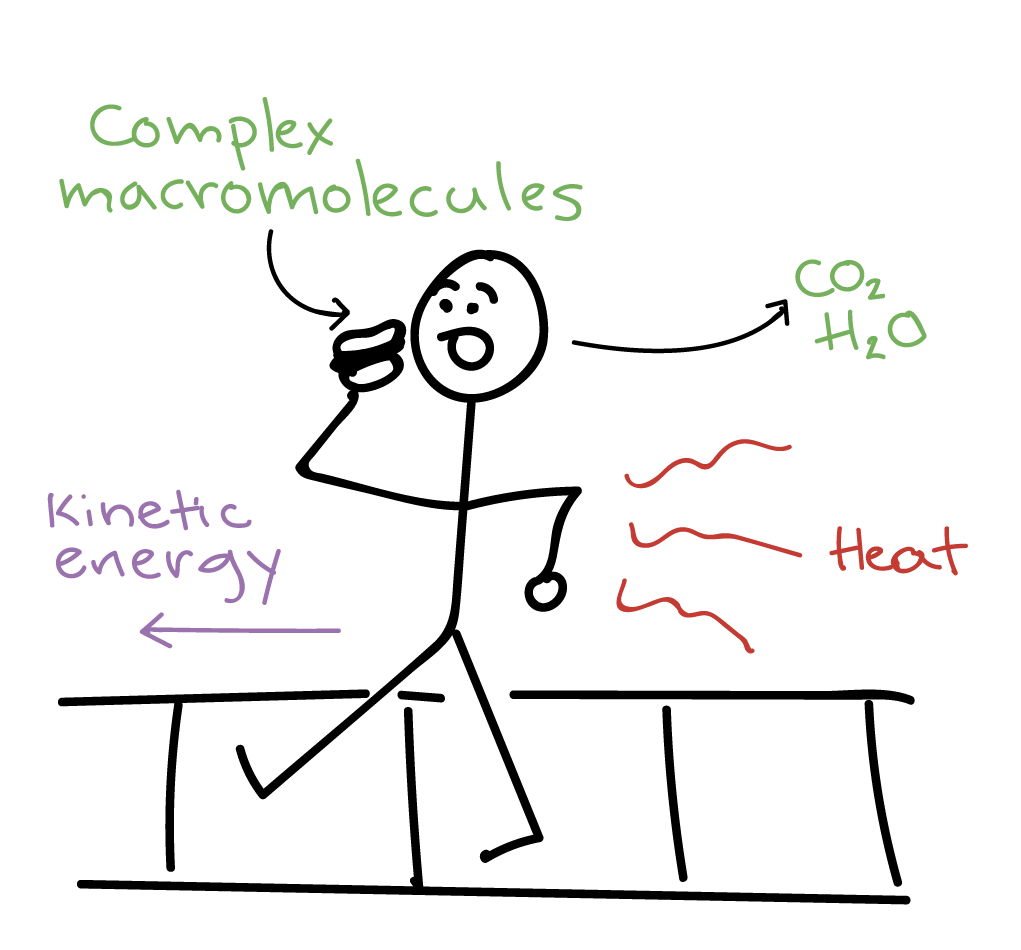Introduction to energy
Types of energy
Introduction
What does it mean to have energy? Well, think about how you feel when you wake up in the morning. If you have lots of energy, that probably means you feel awake, ready to go, and able to do what needs to be done during the day. If you have no energy (maybe because you didn’t get your eight hours of sleep), then you may not feel like getting out of bed, moving around, or doing the things you need to do.
While this definition of energy is an everyday one, not a scientific one, it actually has a lot in common with the more formal definition of energy (and can give you a helpful way to remember it). Specifically, energy is defined as the ability to do work – which, for biology purposes, can be thought of as the ability to cause some kind of change. Energy can take many different forms: for instance, we’re all familiar with light, heat, and electrical energy.
Here, we’ll look at some types of energy that are particularly important in biological systems, including kinetic energy (the energy of motion), potential energy (energy due to position or structure), and chemical energy (the potential energy of chemical bonds). Energy is never lost, but it can be converted from one of these forms to another.
Kinetic energy
When an object is in motion, there is energy associated with that object. Why should that be the case? Moving objects are capable of causing a change, or, put differently, of doing work. For example, think of a wrecking ball. Even a slow-moving wrecking ball can do a lot of damage to another object, such as an empty house. However, a wrecking ball that is not moving does not do any work (does not knock in any buildings).
The energy associated with an object’s motion is called kinetic energy. A speeding bullet, a walking person, and electromagnetic radiation like light all have kinetic energy. Another example of kinetic energy is the energy associated with the constant, random bouncing of atoms or molecules. This is also called thermal energy – the greater the thermal energy, the greater the kinetic energy of atomic motion, and vice versa. The average thermal energy of a group of molecules is what we call temperature, and when thermal energy is being transferred between two objects, it’s known as heat.
Potential energy
Let’s return to our wrecking ball example. The motionless wrecking ball doesn’t have any kinetic energy. But what would happen if it were lifted two stories up with a crane and suspended above a car? In this case, the wrecking ball isn't moving, but there is, in fact, still energy associated with it. The energy of the suspended wrecking ball reflects its potential to do work (in this case, damage). If the wrecking ball were released, it would do work by making a pancake of someone’s poor car. And if the ball is heavier, the energy associated with it will be greater.

Image credit: OpenStax Biology, "Dam," by Pascal.
This type of energy is known as potential energy, and it is the energy associated with an object because of its position or structure. For instance, the energy in the chemical bonds of a molecule is related to the structure of the molecule and the positions of its atoms relative to one another. Chemical energy, the energy stored in chemical bonds, is thus considered a form of potential energy. Some everyday examples of potential energy include the energy of water held behind a dam, or of a person about to skydive out of an airplane.
Energy conversions
An object's energy can be converted from one form to another. For instance, let’s consider our favorite example, the wrecking ball. As the wrecking ball hangs motionless several stories up, it has no kinetic energy, but a lot of potential energy. Once it is released, its kinetic energy begins to increase because it builds speed due to gravity, while its potential energy begins to decrease, because it is no longer as far from the ground. Just before it hits the ground, the ball has almost no potential energy and a lot of kinetic energy.

Image credit: OpenStax Biology. Lower panel, "Car," is a modification of work by Russell Trow.
The same kinds of conversions are possible with chemical energy, and we see lots of examples of this in our day-to-day lives. For instance, octane, a hydrocarbon found in gasoline, has chemical energy (potential energy) due to its molecular structure, which is shown above. This energy can be released in a car engine when the gasoline combusts, producing high-temperature gases that move the engine’s pistons and, ultimately, propel the car forward (kinetic energy)\[^1\]. Part of the chemical energy is converted to the kinetic energy of the car, while part is converted to thermal energy as heat emitted from the engine.
Energy can change forms in a similar way in living organisms. For instance, energy stored in bonds of the small molecule ATP (potential energy) can power the movement of a motor protein and its cargo along a microtubule track, or the contraction of muscle cells to move a limb (kinetic energy).
First Law of Thermodynamics introduction
Introduction to entropy
Second Law of Thermodynamics
Second Law of Thermodynamics and entropy
Why heat increases entropy
The laws of thermodynamics
Introduction
What kind of system are you: open or closed? As it turns out, this is a physics question, not a philosophical one. You, like all living things, are an open system, meaning that you exchange both matter and energy with your environment. For instance, you take in chemical energy in the form of food, and do work on your surroundings in the form of moving, talking, walking, and breathing.
All of the exchanges of energy that take place inside of you (such as your many metabolic reactions), and between you and your surroundings, can be described by the same laws of physics as energy exchanges between hot and cold objects, or gas molecules, or anything else you might find in a physics textbook. Here, we’ll look at two physical laws – the First and Second Laws of Thermodynamics – and see how they apply to biological systems like you.
Systems and surroundings
Thermodynamics in biology refers to the study of energy transfers that occur in molecules or collections of molecules. When we are discussing thermodynamics, the particular item or collection of items that we’re interested in (which could be something as small as a cell, or as large as an ecosystem) is called the system, while everything that's not included in the system we’ve defined is called the surroundings.

For instance, if you were heating a pot of water on the stove, the system might include the stove, pot, and water, while the surroundings would be everything else: the rest of the kitchen, house, neighborhood, country, planet, galaxy, and universe. The decision of what to define as the system is arbitrary (up to the observer), and depending on what you wanted to study, you could equally well make just the water, or the entire house, part of the system. The system and the surroundings together make up the universe.
There are three types of systems in thermodynamics: open, closed, and isolated.
An open system can exchange both energy and matter with its surroundings. The stovetop example would be an open system, because heat and water vapor can be lost to the air.
A closed system, on the other hand, can exchange only energy with its surroundings, not matter. If we put a very tightly fitting lid on the pot from the previous example, it would approximate a closed system.
An isolated system is one that cannot exchange either matter or energy with its surroundings. A perfect isolated system is hard to come by, but an insulated drink cooler with a lid is conceptually similar to a true isolated system. The items inside can exchange energy with each other, which is why the drinks get cold and the ice melts a little, but they exchange very little energy (heat) with the outside environment.
You, like other organisms, are an open system. Whether you think about it or not, you are constantly exchanging energy and matter with your surroundings. For instance, suppose that you eat a carrot, or lift a bag of laundry onto a table, or simply breathe out and release carbon dioxide into the atmosphere. In each case, you are exchanging energy and matter with your environment.
Exchanges of energy that take place in living creatures must follow the laws of physics. In this regard, they are no different from energy transfers in, say, an electrical circuit. Let's take a closer look at how the laws of thermodynamics (physical rules of energy transfer) apply to living beings like yourself.
The First Law of Thermodynamics
The first law of thermodynamics thinks big: it deals with the total amount of energy in the universe, and in particular, it states that this total amount does not change. Put another way, the First Law of Thermodynamics states that energy cannot be created or destroyed. It can only change form or be transferred from one object to another.

Image credit: OpenStax Biology. Credit “Ice cream," modification of work by D. Sharon Pruitt; credit "Kids on bikes," modification of work by Michelle Riggen-Ransom, and credit “Leaf”: modification of work by Cory Zanker.
This law may seem kind of abstract, but if we start to look at examples, we’ll find that transfers and transformations of energy take place around us all the time. For example:
Light bulbs transform electrical energy into light energy (radiant energy).
One pool ball hits another, transferring kinetic energy and making the second ball move.
Plants convert the energy of sunlight (radiant energy) into chemical energy stored in organic molecules.
You are transforming chemical energy from your last snack into kinetic energy as you walk, breathe, and move your finger to scroll up and down this page.
Importantly, none of these transfers is completely efficient. Instead, in each scenario, some of the starting energy is released as thermal energy. When it's moving from one object to another, thermal energy is called by the more familiar name of heat. It's obvious that glowing light bulbs generate heat in addition to light, but moving pool balls do too (thanks to friction), as do the inefficient chemical energy transfers of plant and animal metabolism. To see why this heat generation is important, stay tuned for the Second Law of Thermodynamics.
The Second Law of Thermodynamics
At first glance, the first law of thermodynamics may seem like great news. If energy is never created or destroyed, that means that energy can just be recycled over and over again, right?
Well…yes and no. Energy cannot be created or destroyed, but it can change from more-useful forms into less-useful forms. As it turns out, in every real-world energy transfer or transformation, some amount of energy is converted to a form that’s unusable (unavailable to do work). In most cases, this unusable energy takes the form of heat.
Although heat can in fact do work under the right circumstances, it can never be turned into other (work-performing) types of energy with 100% efficiency. So, every time an energy transfer happens, some amount of useful energy will move from the useful to the useless category.
Heat increases the randomness of the universe
If heat is not doing work, then what exactly does it do? Heat that doesn’t do work goes towards increasing the randomness (disorder) of the universe. That may seem like a big logic jump, so let’s take a step back and see how it can be the case.
When you have two objects (say, two blocks of the same metal) at different temperatures, your system is relatively organized: the molecules are partitioned by speed, with those in the cooler object moving slowly and those in the hotter object moving quickly. If heat flows from the hotter object into the cooler object (as it will spontaneously), the molecules of the hot object slow down, and the molecules of the cool object speed up, until all the molecules are moving at the same average speed. Now, rather than having a partition of between fast and slow molecules, we simply have one big pool of molecules going about the same speed – a less ordered situation than our starting point.
The system will tend to move towards this more disordered configuration simply because it’s statistically much more likely than the temperature-separated configuration (i.e., there are many more possible states corresponding to the disordered configuration). You can explore this concept further in the videos in this tutorial, or in this straightforward physics video.
Entropy and the Second Law of Thermodynamics
The degree of randomness or disorder in a system is called its entropy. Since we know that every energy transfer results in the conversion of some energy to an unusable form (such as heat), and since heat that does not do work goes to increase the randomness of the universe, we can state a biology-relevant version of the Second Law of Thermodynamics: every energy transfer that takes place will increase the entropy of the universe and reduce the amount of usable energy available to do work (or, in the most extreme case, leave the overall entropy unchanged). In other words, any process, such as a chemical reaction or set of connected reactions, will proceed in a direction that increases the overall entropy of the universe.
To sum up, the First Law of Thermodynamics tells us about conservation of energy among processes, while the Second Law of Thermodynamics talks about the directionality of the processes, that is, from lower to higher entropy (in the universe overall).
Entropy in biological systems
One implication of the second law of thermodynamics is that in order for a process to happen, it must somehow increase the entropy of the universe. This may immediately raise some questions for you when you think about living organisms such as yourself. After all, aren’t you a pretty ordered collection of matter? Every cell in your body has its own internal organization; the cells are organized into tissues, and the tissues into organs; and your entire body maintains a careful system of transport, exchange, and commerce that keeps you alive. Thus, at first glance, it may not be clear how you, or even a simple bacterium, can represent an increase in the entropy of the universe.
To clarify this, let’s look at the energy exchanges that take place in your body – say, when you are going for a walk. As you contract the muscles of your legs to move your body forward, you are using chemical energy from complex molecules such as glucose and converting it into kinetic energy (and, if you’re walking uphill, potential energy). However, you’re doing this with pretty low efficiency: a large fraction of the energy from your fuel sources is simply transformed into heat. Some of the heat keeps your body warm, but much of it dissipates into the surrounding environment.

This transfer of heat increases the entropy of the surroundings, as does the fact that you’re taking large, complex biomolecules and converting them into a lot of small, simple molecules, such as carbon dioxide and water, as you metabolize fuel to power your walk. This example uses a person in motion, but the same would be true for a person, or any other organism, at rest. The person or organism will maintain some basal rate of metabolic activity, causing the breakdown of complex molecules to smaller and more numerous ones and the release of heat, thus increasing the entropy of the surroundings.
Stated more generally, processes that locally decrease entropy, such as those that build and maintain the highly organized bodies of living things, can indeed take place. However, these local decreases in entropy can occur only with an expenditure of energy, where some of that energy is converted into heat or other non-usable forms. The net effect of the original process (local decrease in entropy) and the energy transfer (increase in entropy of surroundings) is an overall increase in the entropy of the universe.
To sum up, the high degree of organization of living things is maintained by a constant input of energy, and is offset by an increase in the entropy of the surroundings.
